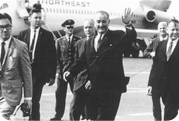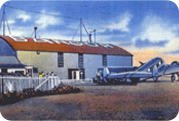The history of Bangor International Airport
Bangor International Airport began as “Godfrey Field” in 1927, on land owned by local attorney Edward Rawson Godfrey (1877-1958). Regular air passenger service to Portland and Boston began in 1931 by Boston-Maine Airways, owned by the Boston and Maine and Bangor and Aroostook railroads, but under contract to Pan American which was interested in the airport as one stop on its planned intercontinental air route between the US and Europe. In 1940 Boston-Maine became Northeast Airlines, which eventually merged with Delta Airlines in 1972. Amelia Earhart was a celebrity pilot on some of the earliest flights for Boston-Maine Airways in the 1930s. The airport was equipped with floodlights for night flights as early as 1937.
Just prior to the Second World War, Godfrey Field was taken over by the U.S. Army Air Corps and became the Bangor Army Air Field. Its mission was to serve as an embarkation point for military aircraft flying to Europe on the Great Circle Route. The name was changed to Dow Army Airfield in 1942, and in 1947, when the newly formed U.S. Air Force took control, it became Dow Air Force Base. In 1958 the longest runway east of the Mississippi was constructed at Dow in order to accommodate B-52 bombers; the same runway that accommodates jet passenger aircraft today. In addition to strategic bombers, Dow was home to the 101st Fighter Wing, which, converted to a refueling wing, still shares space with the airport today, flying predominantly Boeing KC-135 Stratotankers. Some of the other military aircraft that regularly use the airport are McDonnell Douglas KC-10 Extenders and Boeing C-17 Globemasters.
In the 1950s and 60s, Bangor was a destination for Northeast Airlines before its merger into Delta. Northeast usually used the DC-6 for service between Bangor and Boston and New York. In 1965 there was still a single weekly DC-3 flight to Bangor operated by Northeast Airlines.
Dow was closed in 1968, but the base was purchased by the city of Bangor and reopened the following year as Bangor International Airport. From the 1970s into the 1990s the airport attracted 3,000-5,000 commercial flights a year, mostly charter jetliners flying between Europe and the West Coast of the United States, or the Caribbean and Mexico. Bangor was a logical refueling stop, and as a U.S. Port of Entry, passengers could go through customs and immigration checks while their plane was being serviced. Travelers from every part of the world mingled in the airport lounge – from the French & Belgian contingents of the Elvis Presley Fan Club on their way to Memphis to President Jose Lopez Portillo of Mexico on his way to Moscow with members of his military staff. Laker Airways, World Airways, Balair, Condor Airlines, LTU International, Capital International Airways, Aeroflot and Pan American were a few of the companies whose livery became common in the skies above Bangor. Finnair briefly used Bangor as a hub for regularly scheduled daily flights.
Bangor has been the port of entry for over half a million servicemen and women returning from the First and Second Gulf Wars and the action in Bosnia on military charters. Starting in 1991, a combination of local veteran’s groups and interested citizens formed themselves into troop greeters, to avoid the situation of the Vietnam War when soldiers returned without ceremony or greeting. The civilian-driven ‘ceremony of return’ in Bangor has been well organized and often ebullient. On September 23, 2004, President George Bush boarded a plane carrying the troops of the 30th National Guard Brigade Combat Team as they stopped at Bangor International to refuel along their way to Iraq. In 2006, former President Bill Clinton spontaneously joined the line of troop-greeters when his private plane made a refueling stop.
In 2018, BGR celebrated its 50th anniversary. Read more about the history of BGR and this milestone.


